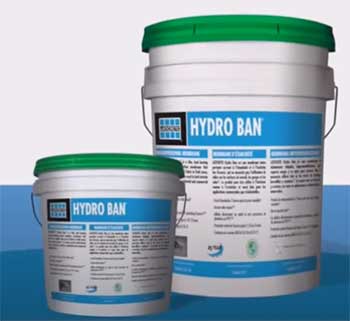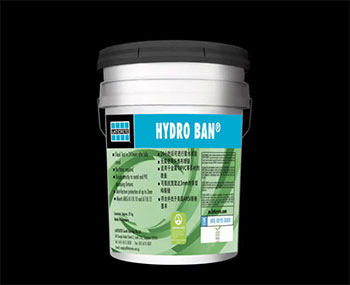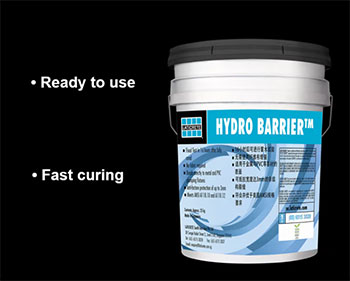Laticrete needs no introduction for making premium-quality waterproofing products. Hydro Ban and Hydro Barrier are two of them. So, what is the core difference between Hydro Ban vs. Hydro Barrier?
A Hydro Ban is a liquid rubber polymer that is used on a wide variety of substrates. And Hydro Barrier, known as a shower pan liner, is used primarily for interior and exterior surfaces.
Let’s learn details about these two waterproofing products for your bathroom.
A Quick Comparison Table
Can’t wait to learn about these two waterproofing products? Take a look at the table to get a quick summary of them.
| Specification | Hydro Ban | Hydro Barrier |
| Materials | Waterproofing/crack isolation membrane | Self-curing liquid rubber polymer |
| Fabric | No need to use any fabric | Need to use fabric |
| Change in color | a light sage to an olive green | a light blue to darker blue |
| Flood testing | 2 hours | 24 hours |
| Drying Time | 1-2 hours | 2-3 hours |
| Curing Time | 2 hours | 4–6 hours |
| Suitable Substrates | Many uncommon Substrates | Most common surfaces |
| Cost | Expensive | Less expensive |
Differences Between Hydro Ban And Hydro Barrier

- Materials
Hydro Ban works like paints on various surfaces. This liquid waterproofing membrane is an easy-to-use waterproofing product suitable to use for multiple appropriate substrates.
It has a special liquid rubber polymer. When you apply the liquid waterproofing membrane, it creates a pliable and smooth waterproof seal.
You can use paint rollers, trowels, paintbrushes, or even airless paint sprayers to apply this crack isolation/ waterproofing membrane on your preferred surface.
Additionally, it plays a crucial role in preventing cracks for the tile and stone installations. But its anti-fracture protection is only for 1/8″ (3 mm); not more than that.
Hydro Barrier is another high-quality and effective liquid waterproofing membrane. You can easily install tile, brick, and stone directly onto the membrane.
Compared to Hydro Ban, Hydro Barrier is an economical choice. You can use it on both external and internal locations on vertical and horizontal surfaces.
- Fabric
So, how this waterproofing membrane is different from others? You don’t need to use any fabrics while using it on the corners or seams.
You simply paint on those tricky areas. Allow them to dry. Then, they’ll become completely waterproof.
On the contrary, you’ve to use waterproofing fabric while applying the membrane on the seams and corners.
Though using other brands won’t cause many problems, Laticrete waterproofing membrane fabric is more convenient. After all, they’re from the same brand. Better compatibility will be ensured.
- Change In Color
After applying the Hydro Ban on your preferred surface, their color will turn into olive green from a light sage when it’s fully cured.
On the other hand, the color of the Hydro Barrier will turn into darker blue from light blue when it’s fully cured.
Generally, the company has kept light color for the initial stage. The more time passes, the darker color they’ll develop. This lets you have a clear idea of how much the waterproofing product has dried or cured.
- Flood Test
Hydro Ban allows you to do the flood test for a particular surface within two hours.
So, once the two hours have passed, you can examine the effectiveness of the waterproofing system on how much water the horizontal surface can temporarily retain.
For flood testing, you’ve to maintain a temperature of 70°F (21°C) or higher based on the surface you’re applying.
On the contrary, you’ve to wait at least 24 hours to flood test using Hydro Barrier. Hydro Barrier takes a little more time to form a pliable, smooth waterproof / anti-fracture membrane, unlike Hydro Ban.
- Drying Time
Hydro Ban takes only 1-2 hours to dry. Once the surface is appropriately dried up, it’s ready for using tiles.
However, their drying time may increase or reduce based on airflow, temperature, film thickness, and humidity.
On the contrary, Hydro Barriers will take 2-3 hours to dry. Generally, they take a little more time to form a suitable membrane.
- Curing Time

Due to the higher effective materials and quick drying process, Hydro Ban takes only 2 hours to cure.
So, once two hours pass, you can tile the surface and finish your project to daily use.
However, it’s better to wait a little more time because your application method and surrounding environment may require you to wait some additional period for better results.
On the other hand, the curing for Hydro Barrier will be around 4–6 hours. It’s better to maintain 70°F (21°C) and 50% RH when using this waterproofing product.
But if the temperature is less than 70°F (21°C) and the RH is more than 50%, it’ll take considerably more time to cure.
- Suitable Substrates
Generally, Hydro Ban and Hydro Barrier are suitable to use many common substrates such as Concrete and Brick Masonry, Poured Gypsum Underlayment, Exterior Glue Plywood, Cement Mortar Bed, etc.
However, you can use Hydro Ban on some uncommon substrates such as Self-Leveling and Patching Compounds, Clay Tile, Vinyl Flooring, which you can’t use for Hydro Barrier.
- Cost
Compared to Hydro Barrier, the price of Hydro Ban is higher. High quality and fast-drying and curing time make Hydro Ban a more expensive option than Hydro Barrier.
When you want to use both Hydro Ban and Hydro Barrier, it’s better to use Hydro Ban in the key areas, and you can use Hydro Barrier on the lion’s share of the locations.
This approach will save your cost.
Use Hydro Ban where you need extra stretch and strength to go a long way without changing them. But you’ll still get proper protection from Hydro Barrier for the large areas.
Their exceptional waterproofing and anti-fracture protection ensure long-lasting durability.
Key Features of Hydro Ban Waterproofing Membrane
- Flexible Sheet Material
Hydro Ban is a flexible sheet material made from a synthetic rubber polymer. The membrane is vapor-permeable but waterproof. This allows moisture to escape from the substrate while preventing liquid water from penetrating through.
The flexibility of the material makes Hydro Ban easy to install around corners and in tight spaces. It can bridge cracks up to 1/8″ wide.
- Thin Profile
At only 30 mils thick, Hydro Ban adds minimal thickness to the installation. This allows it to be used under tile and stone without significantly altering the profile of the finished surface. The thin membrane easily fits into tight spaces.

- Bonds Directly to Substrates
Hydro Ban bonds directly to a variety of common substrates like concrete, plywood, and cement backerboard.
No prior sealing or substrate preparation is required for application. The adhesive properties allow it to be applied directly onto the surface without any loops or gaps.
- Immediate Exposure to Water
Hydro Ban can be exposed to water immediately after installation. There is no need to wait for curing like other liquid-applied membranes. This allows for faster turnaround times during construction and renovation projects.
The membrane maintains its waterproofing abilities even if exposed to water right after application.
- Applied with Paint Roller
Hydro Ban is rolled on using a paint roller, brush, or trowel. This makes application quick and easy compared to sheet membranes or liquid coatings that require specialized tools.
The roller application ensures proper adhesion and coverage on every square inch of the substrate. No specialized training or equipment is needed to apply it.
- Safe for Use Indoors
The Hydro Ban membrane has low VOC emissions, making it safe to use in interior applications. There are no harsh fumes or odors during application and curing. It meets regulations for use in occupied buildings and conditioned spaces.
The water-based adhesive is non-flammable and non-toxic.
In summary, Hydro Ban is a thin, flexible, and versatile waterproofing membrane that bonds tenaciously to substrates. It can be applied easily with basic tools and creates a seamless water barrier that allows moisture vapor to escape.
Advantages of Hydro Ban:
- Super adhesive – bonds directly to metal, PVC, acrylic, and other common substrates
- Does not require fabric reinforcement (Hydro Barrier does)
- Allows for same day tile installation
- Relatively easy to inspect and repair
- Crack isolation up to 1/8″
Potential drawbacks:
- Requires skill to apply evenly at proper thickness
- Flood testing mandatory before tiling
- More expensive than sheet membranes like Hydro Barrier
These key features make Hydro Ban an effective solution for waterproofing bathrooms, showers, and other interior spaces.
Key Features of Hydro Barrier Waterproofing Membrane
- Elastomeric Material
Hydro Barrier is made from an elastomeric polyurethane material that is stretchy and flexible. The elastic properties allow the membrane to bridge cracks and move with the substrate.
It can stretch and compress without damage to maintain a watertight seal. The flexibility makes wrapping Hydro Barrier around complex geometries straightforward.
- Cold Liquid Application

Hydro Barrier is applied as a thick cold liquid using rollers, brushes, or spray equipment. This makes it easy to apply on horizontal or vertical surfaces.
The cold liquid application means no flame heating or special equipment is required.
The liquid properties allow it to flow into cracks, seams, and details for complete coverage.
- Bonds to Substrates
Hydro Barrier chemically bonds with concrete, masonry, wood, and metal to create a monolithic membrane. No primers, felts, or reinforcing fabrics are needed prior to application.
The liquid effectively seals around penetrations, flashings, and transitions. This provides a seamless, self-flashing membrane.
- Waterproof Under Continuous Hydrostatic Pressure
Hydro Barrier maintains its waterproofing abilities even under continuous hydrostatic pressure. It can withstand up to 14 PSI of pressure from liquid water without leaking.
This high-pressure resistance makes it suitable for below-grade foundation walls, plaza decks, and below-ground structures.
- Allows Vapor Diffusion
While waterproof, Hydro Barrier still allows for the diffusion and evaporation of moisture vapor. This “breathability” prevents moisture from being trapped in the substrate. It reduces the risk of problems like mold, mildew, and freeze-thaw damage in wall assemblies.
- Withstands High Temperatures
Once fully cured, Hydro Barrier remains elastomeric even when exposed to temperatures up to 300°F. This thermal stability makes it suitable for hot environments and applications with temperature fluctuations. The membrane stays intact through freeze-thaw cycles and summer heat waves.
- Resistant to Chemicals and Salts
Hydro Barrier resists damage from common chemicals like acids, alkalis, fuels, oils, and solvents. It also has high salt-resistance, allowing it to be used in marine environments and areas subject to saltwater spray or deicing salts. The chemical resistance provides long-term durability.
In summary, Hydro Barrier is a cold-applied, elastomeric liquid membrane with superior elongation, adhesion, and durability.
Hydro Barrier offers these advantages:
- Cost-effective compared to liquid membranes
- Thicker than Hydro Ban for robust water protection
- Seams and corners can be tightly sealed
- Nospecial skills needed for installation
- Fabric reinforcement for extra durability
Potential disadvantages:
- Less flexible and adhesive than Hydro Ban
- More difficult to inspect once installed
- Flood testing not required (risk of pinholes)
- Must wait 24 hours before applying tile
These attributes make it an ideal choice for below-grade waterproofing and applications demanding a seamless, self-flashing membrane able to withstand harsh conditions. It bonds tenaciously to various substrates to form a water and vapor barrier.
Which One to Choose Between Hydro Ban and Hydro Barrier?
It depends on the substrates. If you want to use a waterproofing product for any common substrates and choose a budget-friendly option, Hydro Barrier will be more appropriate.
But, if you want to use more high-quality waterproofing products on uncommon surfaces such as Self-Leveling and Patching Compounds or Clay tiles, Hydro Ban is the best pick.
However, a big project may significantly increase the overall cost since Hydro Ban is more expensive than Hydra Barrier.
According to many plumbing maintenance technicians, it’s better to use both to get a better and long-lasting result. For example, you’ll use Hydro Ban to those spots where it requires a little more stretch and strength.
And use Hydro Barrier to other locations of the project. This will help you save money while getting the most reliable outcome. Here is how you should apply Hydro Barrier.
Frequently Asked Questions (FAQ)
You have to apply two coats of Hydro Ban for better results and a reliable waterproof system.
Most of the time, Hydro Barrier can be applied over Hydro Ban. But make sure the Hydro Ban isn’t roughly used. Otherwise, the paint will be visible.
Hydro Barrier is a waterproofing sheet membrane made of chlorinated polyethylene (CPE). It is designed to be installed behind tile walls in wet areas like showers, tub surrounds, and bathroom floors to prevent water intrusion and leaks. The 40 mil thick membrane adheres to surfaces with thinset mortar to form a water tight barrier.
No, Hydro Ban and RedGard are two different liquid-applied waterproofing membranes made by competing manufacturers. Hydro Ban is created by Laticrete while RedGard is a product of Custom Building Products. Both products are designed for similar usage in wet room tile installations. The main difference is the formula – Hydro Ban uses an acrylic base while RedGard is derived from latex. Performance is comparable between the two.
No, Hydroban is designed solely as a waterproofing membrane, not a vapor barrier. It allows for the transmission of vapor and moisture through the substrate while blocking liquid water penetration. If a vapor barrier is required, a separate product like Laticrete Air and Water Barrier would be installed prior to the Hydroban.
Hydroban is considered an excellent quality waterproofing membrane and is widely trusted by professional tilers. Advantages include superior adhesion, crack resistance, and rapid drying time. When properly applied at the right thickness, Hydroban forms a seamless waterproof barrier that prevents leaks in wet tile installations. Pre-tiling flood tests also help ensure an effective application free of flaws or thin spots.
Conclusion
Haven’t you already learned all the essential details about Hydro Ban vs. Hydro Barrier?
You should be!
We have outlined all the precise information about these two waterproofing products.
Plus, you’ve got a clear idea when you should use them at what Suitable Substrates. Hopefully, this article has helped make an impactful decision to select the correct product for your upcoming project.
